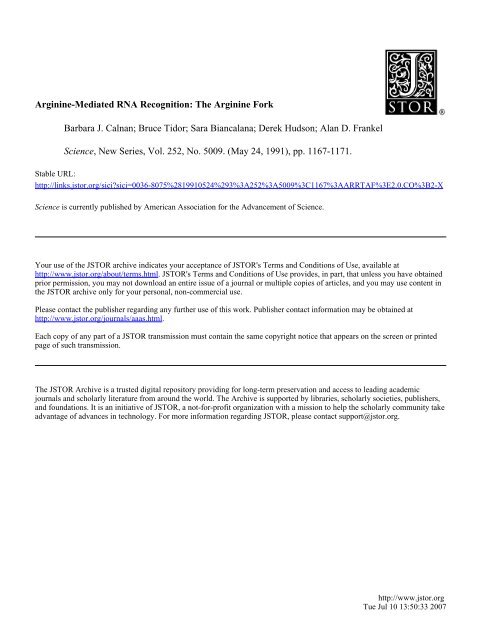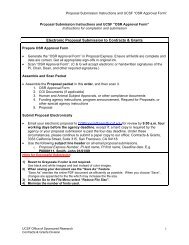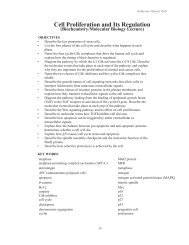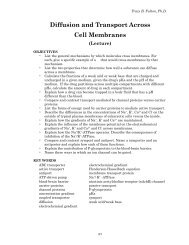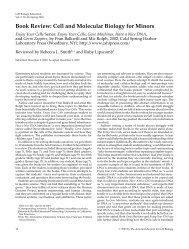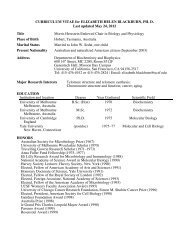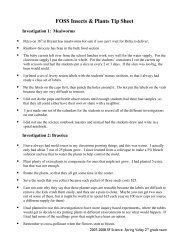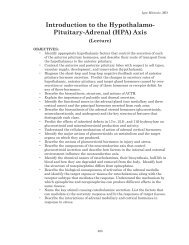Arginine-Mediated RNA Recognition: The Arginine ... - ResearchGate
Arginine-Mediated RNA Recognition: The Arginine ... - ResearchGate
Arginine-Mediated RNA Recognition: The Arginine ... - ResearchGate
Create successful ePaper yourself
Turn your PDF publications into a flip-book with our unique Google optimized e-Paper software.
<strong>Arginine</strong>-<strong>Mediated</strong> <strong>RNA</strong> <strong>Recognition</strong>: <strong>The</strong> <strong>Arginine</strong> ForkBarbara J. Calnan; Bruce Tidor; Sara Biancalana; Derek Hudson; Alan D. FrankelScience, New Series, Vol. 252, No. 5009. (May 24, 1991), pp. 1167-1171.Stable URL:http://links.jstor.org/sici?sici=0036-8075%2819910524%293%3A252%3A5009%3C1167%3AARRTAF%3E2.0.CO%3B2-XScience is currently published by American Association for the Advancement of Science.Your use of the JSTOR archive indicates your acceptance of JSTOR's Terms and Conditions of Use, available athttp://www.jstor.org/about/terms.html. JSTOR's Terms and Conditions of Use provides, in part, that unless you have obtainedprior permission, you may not download an entire issue of a journal or multiple copies of articles, and you may use content inthe JSTOR archive only for your personal, non-commercial use.Please contact the publisher regarding any further use of this work. Publisher contact information may be obtained athttp://www.jstor.org/journals/aaas.html.Each copy of any part of a JSTOR transmission must contain the same copyright notice that appears on the screen or printedpage of such transmission.<strong>The</strong> JSTOR Archive is a trusted digital repository providing for long-term preservation and access to leading academicjournals and scholarly literature from around the world. <strong>The</strong> Archive is supported by libraries, scholarly societies, publishers,and foundations. It is an initiative of JSTOR, a not-for-profit organization with a mission to help the scholarly community takeadvantage of advances in technology. For more information regarding JSTOR, please contact support@jstor.org.http://www.jstor.orgTue Jul 10 13:50:33 2007
Flg. 4. Positional dcpcndcmr of arginine. l'hcbasic @on of Tat was qlaccd by eight lys'iand a sin& vginine located at the amino acidpositions indicated. Plasmids (25 ng) war uansfcctcdinm HeLa & and transactivation wasdctcsmhed as in Fig. 2.formation for this interaction, molecularmodeling (13) was used to locate the mostfavorable positions of two phosphates withhydrogen (H)-bonds to arginine. Thc bestarrangement (Fig. 6B) has a pair ofH-bonds between a phosphate and twoN,'s, and another pair of H-bonds betweenthe second phosphate and NY1 and N,. Eachphosphate is shared by a pau of nitrogem,with a dhance between phosphates of7.1 A(center to center dhance between phosphorusatoms). We define the atginine fork as aninteraction between a single arginine and apair of adjacent phosphates, which mediatesspecitic recognition of <strong>RNA</strong> strum. 0therarginine-ph&phate Fments are possible(for example, see legend to Fig. 6B),and arginine forks with additional H-bondsare possible (for example, with a specificbase or a 2' OH).To determine whether such phosphate~tsarefoundin<strong>RNA</strong>saucturrs,the modelad phosphate coordinates fiomFig.6B were superimposed on all phosphatepairs in t<strong>RNA</strong> crystal sauctures (14). Thcresults indicate that double-stranded A-form<strong>RNA</strong> cannot readily accommodate this arranguncnt;the P-P dismnce in the model(7.1 A) is longer than the P-P distance inA-form <strong>RNA</strong> (5.6 A), and the phosphateoxygcns in A-form <strong>RNA</strong> are not properlyoriented to form H-bonds between a slnglearginine and a pair of adjacent phosphates.Reasonable H-bonding arrangements aremuch mom likcly to be found at discontinuousregions of kNA, for example, at junctionsbetween double-stranded A-form<strong>RNA</strong> and a bulge or loop. <strong>The</strong> two criticalphosphates in are focated precisely atthe junction of the double-stranded stemand the 3-nudaotide bulge.<strong>The</strong> coaystll saucture of glutaminylt<strong>RNA</strong> syntheme-t<strong>RNA</strong> shows a similarinteradon of arginine with the acceptorstrand of t<strong>RNA</strong> (1). Arg133 forms H-bondswith two adjacent phosphates and an additionalH-bond with a ribose 2' OH. It isplausibkthatthearginineinTatahoimuactswith a 2' OH, thus discriminating between<strong>RNA</strong>andDNA(4).~wecannotrukout bascspecific comaas, fbr example, with anessentialuridiminthebulge(4,5, ll),itseensreasonablethatomtaasbetweenonearginineand a highly oriamd pair of pho@m&s canacaruntfin-themodestlo-to20-foldspccific-ity &Tat b i i to TAR (4, 5, 11). <strong>The</strong>~that~theovaallfbldingofTARandtheorientdtionoftheseparticularphcqhmxwnaintobedaamined.Inadditiontothe~cargininecontact,thechargeM t y ofthe basic region &Tat is importantfbrbii(5) andmayprovideanonspecific~c~ldtohelporientthe~.Tatisperhapsthesimplestarampkof<strong>RNA</strong>rewgdion in that a singk amino acid interactswith a single feature of the <strong>RNA</strong>; other p nteinsmayachievthighcrspecificirythmughmulliple algink<strong>RNA</strong>0rotherina;lctions.In the case of Tat, akhaugh <strong>RNA</strong> binding iscsaxial fbrthe modcst speciiicityfbrTARis~toaccountfbrthehigh spacificity &Tat function Other interactionsofTat,perhapswithcdtularpm&s,arelikely to be required.<strong>The</strong> recognition of TAR by Tat highlightsfundamental dXmnces between<strong>RNA</strong> recognition and DNA recognition. ItFlg. 5. Ethylation in- of R52, K, andwild-typc Tat pptidcs. Pcptides wac bound mahylated TAR <strong>RNA</strong> unda gel-shift conditiomthat gavc
interactions beyond 8.5 A smoothed to zero by use of ashifahg Function for electrostatic terms and a switchingfunction for van der Waals terms. A boundary potentialwas used to keep the dimethylphosphates within thesphere. Langevin molecular dynamics simulated annealingwas performed on this potential surface for 4.75 ps,starting at 1000 K andcooling slowly to 10 K. <strong>The</strong> finalconfiguration was fiuther opdmized by performing 100steps of ABNR (adopted-basis Newton-Raphson) minimization.<strong>The</strong> entire procedure was repeated fivetimes starting from different random configurationsand the interaction energy of each dimethylphosphatepair with the arginine was calculated.<strong>The</strong> configuration with the most favorable interactionenergy is shown (Fig. 6B).14. Coordinates of two t<strong>RNA</strong> clystal structures (yeast Pheand Asp t<strong>RNA</strong>s) in the Brookhaven Protein Data Bank[F. C. Bemstein et al., J. Mol. Biol. 112, 535 (1977)]were searched to determine the location of phosphatepairs oriented in a manner similar to the phosphates inFig. 6B. We required the P-P distance to be between6.5 and 7.5 A and the free oxygens (01P and 02P) topoint toward each other. Although more shingentcriteria are possible (for example, requiring oxygenoxygendistances to match the modeling results moreclosely), a broader range of phosphate orientations wasaccepted to accommodate other possible conformationsindicated by the modeling (see legend to Fig. 6B) orconformational changes that might occur uponarginine binding. Three types of phosphate pairswere found: phosphates adjacent in the sequence(i, i+l), those one away from each other (i, i+2),and those distant in primary sequence but neareach other in the tertiary structure. In no case didphosphate pairs in double-stranded <strong>RNA</strong> matchthe template. <strong>The</strong> (i, i+l) pattern frequently appearedsurrounding the first or last unpaired basein a bulge or loop, and the (i, i+2) patternfrequently appeared in a bulge or loop that bounda hydrated magnesium ion. In fact, water moleculescoordinated to MgZ+ produce an array ofhydrogen-bond donors similar to that of an arginineside chain (Fig. 6A) and bind to a phosphatepair in a manner similar to Fig. 6B.15. T. A. Steitz, Quart. Rev. Biophys. 23, 205 (1990).16. Q. You, N. Veldhoen, F. Baudin, P. J. Romaniuk,Biochemistry 30, 2495 (1991).17. For examples see J. D. Puglisi, J. R. Wyatt, I. Tinoco,Jr., Bwchemktry 29,4215 (1990); A. Bhattacharya, A.I. H. Murchie, D. M. J. Liey, Nature 343,484 (1990);C. Cheong, G. Varani, I. Tioco, Jr., ibd. 346,(1990).18. J. D. Puglisi, J. R. Wyatt, I. Tinoco, Jr., J. Mol.Biol. 214, 437 (1990).19. T. J. Daly, J. R. Rusche, T. E. Maione, A. D.Frankel, Biochemistry 29, 9791 (1990).20. K. Nagai, C. Oubridge, T. H. Jesse, J. Li, P. R.Evans, Nature 348, 515 (1990).21. J. Christiansen, R. S. Brown, B. S. Sproat, R. A.Garrett, EMBO J. 6, 453 (1987).22. M. Yarus, Science 240, 1751 (1988); F. Michel, M.Hanna, R. Green, D. P. Bartel, J. W. Szostak,Nature 342, 391 (1989).23. M. A. Lischwe, R. G. Cook, Y. S. Ahn, L. C. Yeoman,H. Busch, Biochemistry 24,6025 (1985); M. E. Christensenand K. P. Fuxa, Biochem. Bwphys. Ra. Comm.155, 1278 (1988).24. We thank D. Rio, P. Sharp, A. Sachs, J. Williamson, P.Kim, and A. Miranker for helpful discussions, and C.Pabo for comments on the manuscript. Supported bythe Lucille P. Markey Charitable TIUS~ by NM grantW9135 (A.D.F.), and by a grant from the PittsburghSupercomputing Center (B.T.).7 March 1991; accepted 4 April 1991Requirement of GTP Hydrolysis for Dissociation ofthe Signal <strong>Recognition</strong> Particle from Its Receptor<strong>The</strong> signal recognition particle (SRP) directs signal sequence specific targeting ofribosomes to the rough endoplasmic reticulum. Displacement of the SRP from thesignal sequence of a nascent polypeptide is a guanosine triphosphate (GTP)-dependentreaction mediated by the membrane-bound SRP receptor. A nonhydrolyzable GTPanalog can replace GTP in the signal sequence displacement reaction, but the SRP thenfails to dissociate from the membrane. Complexes of the SRP with its receptorcontaining the nonhydrolyzable analog are incompetent for subsequent rounds ofprotein translocation. Thus, vectorial targeting of ribosomes to the endoplasmicreticulum is controlled by a GTP hydrolysis cycle that regulates the afKnity between theSRP, signal sequences, and the SRP receptor.RIBOSOMES SYNTHESIZING PROTEINSwith rough endoplasmic reticulum(RER)-specific signal sequencesare cotranslationally recognized by SRPsand then delivered to the RER membranevia interaction between the SRP and theSRP receptor or docking protein (14).<strong>The</strong>SRP receptor-mediated displacement of theSRP from the signal sequence of the nascentpolypeptide is a GTP-dependent reaction(5-7). One protein subunit from both theSRP receptor (SRa) (7) and the SRP(SRP54) (8, 9) contains protein sequencemotifs that are similar to those in GTPbinding proteins (10). We examined the roleof GTP hydrolysis in SRP receptor hnctionby replacing GTP with the nonhydrolyzableanalog p-y-imidoguanosine 5'-triphosphate[Gpp(NH)p] during the targeting and in-Department of Biochemistry and Molecular Biology, University of Massachusetts Medical School, Worcester, MA 01655. *Present address: Cold Spring Harbor Laboratory, Cold Spring Harbor, NY 11724. tTo whom correspondence should be addressed. 24 MAY 1991 sertion steps of a protein translocation reaction.A truncated m<strong>RNA</strong> encoding the NH2-terminal 90 residues of the G protein ofvesicular stomatitis virus was translated invitro in the presence of lZ5I-labeled SRP toprepare complexes containing SRP, ribosomes,and a nascent polypeptide. Aftertranslation, ribonucleotides were removedby gel filtration chromatography, and theSRP-ribosome complexes were incubated inthe absence or presence of Gpp(NH)p andmicrosomal membranes that were depletedof SRP (K-RM) (Fig. 1, A and B). <strong>The</strong>SRP-ribosome complexes were then separatedfrom free SRPs by sedimentation onsucrose density that were underlayeredwith a 2 M sucrose cushion. Underthese conditions, membrane vesicles sedimentat the interface between the sucroselayers. Addition of K-RM and GTP to thecomplexes increased the amount of unboundSRP recovered after centrifugationwhile the amount of SRP bound to ribosomesdecreased (Fig. 1,A and c),indicatingthat the SRP enters a soluble pool. In10 30 50 10 30 50 FractionFig. 1. Recycling of SlU? after GTP hydrolysis. Atruncated m<strong>RNA</strong> transcript (7, 16) was incubatedfor 20 min in a wheat germ system containing 6.5nM SlU? (including lZ5I-labeled SRP) (3, 7, 19).SRP-ribosome complexes were separated from ribonucleotides(5)and incubated in 50 mM methanolamine-acetate,pH 7.5, 150 mM potassium acetate,2.5 mM magnesium acetate, and 1mM dithiothreito1for 5 min at 25°C as follows. (A) No addtions,(B) K-RM [5 equivalents, as defined (3)], (C)K-RM(5 equivalents) and 100 pM GTP, and (D) K-RM (5equivalents) and 100 pM Gpp(NH)p. <strong>The</strong> abbreviationK-RM refers to rough microsomal membranesdepleted of SRPs by emaction with 0.5 M potassiumacetate (3). Samples were applied to sucrosedensity gradients (10 to 30%) underlain with 0.5 mlof 2 M sucrose. <strong>The</strong> gradients contained 50 mMtriethanolarnine-acetate,pH 7.5,150 mM potassiumacetate, 5 mM magnesium acetate, and 1mM dithiothreitol.Cennifugation, fractionation, and quantitationof gradients were as described (3, 7). <strong>The</strong> topand bottom of the gradient were in fractions 1and50, respectively. <strong>The</strong> interface between the sucroselayers was in fraction 45. <strong>The</strong> sedunentation positionof 80s ribosomes (fractions 14 to 20) was determinedfrom the ultraviolet-absorbence profile as recordedwith a continuous flow cell. Free SRPs sedmentedin fractions 1 to 5 in gradients lackingribosomes. Sinular results were obtained in threeseparate experiments.REPORTS 1171


